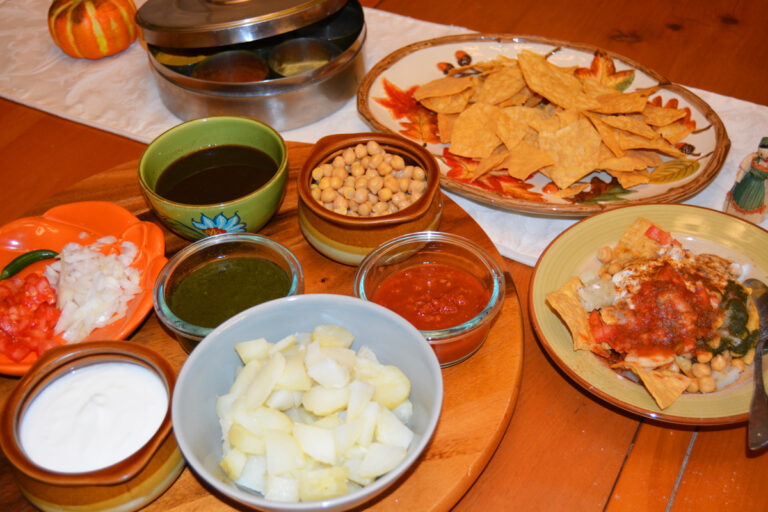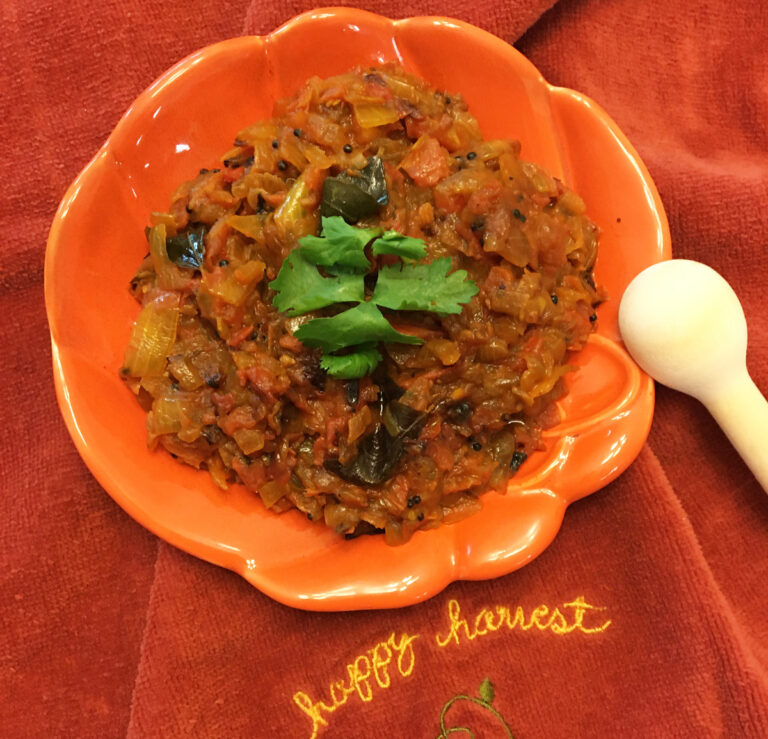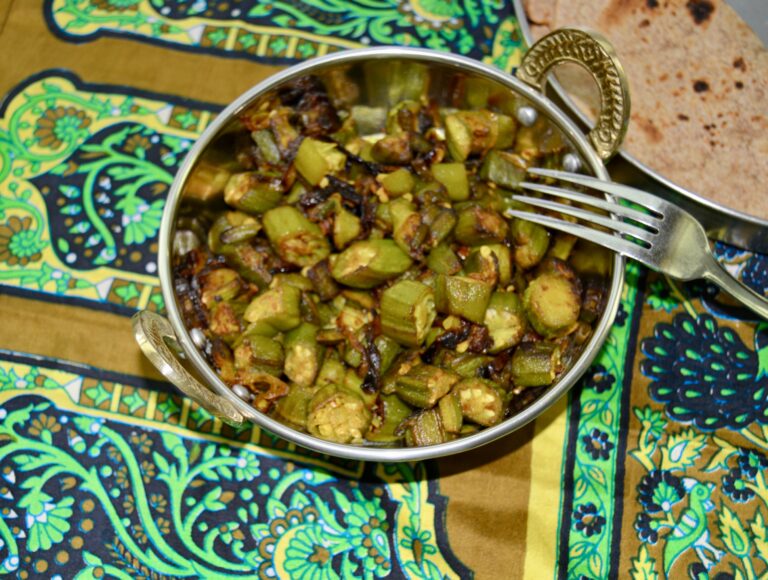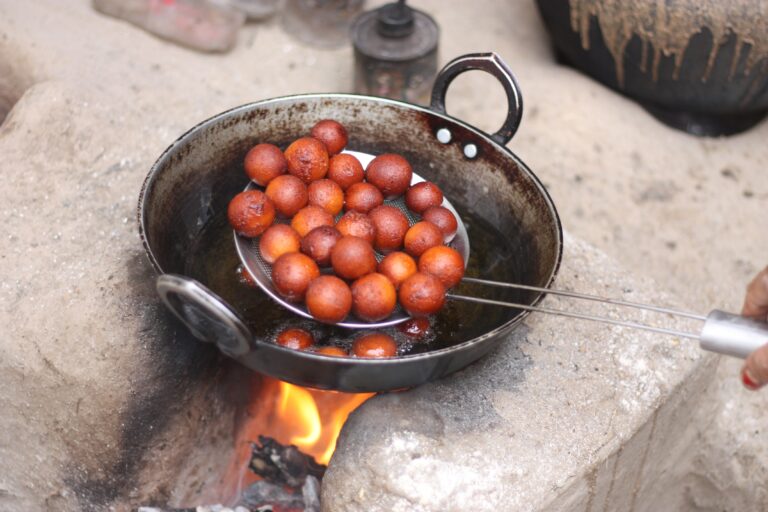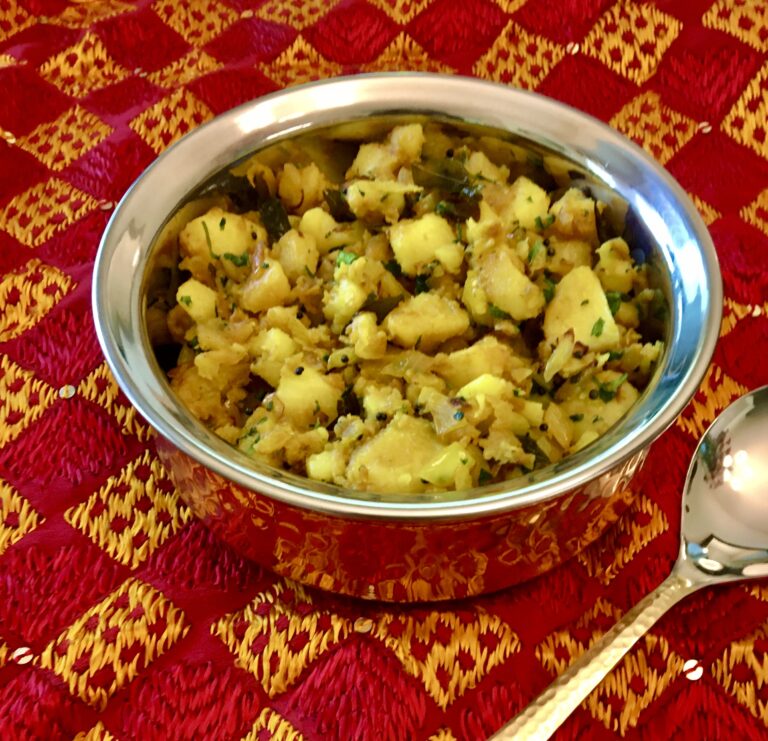Living in California and getting to taste Mexican cuisine, it struck me how similar some of their spices were to Indian cuisine. Their tortillas are similar to our roti (chapati, phulka). The wheat tortillas are my favorite go-to when I don’t feel like making rotis—which is pretty often!
The taco chips are almost like papads and papdi. It didn’t take me long to start a fusion of the two cuisines. One such creation is papdi chaat made with corn chips. Papdis are little round deep fried discs of flour that are topped with several ingredients. Chaat is a North Indian street food snack, but it is substantial enough to be a meal.
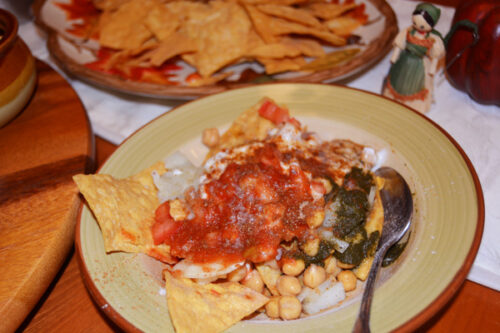
Corn Chip Papdi Chaat
Ingredients
- 2 cups potatoes boiled, peeled, and chopped (The cook time to boil the potatoes is approximately 30 minutes. )
- 2 cups chickpeas, boiled (45 mins to boil chickpeas (if soaked overnight or boil with salt until cooked). )
- 2 cups restaurant-style corn chips (yellow or white)
- 1 cup tamarind chutney
- 1 cup chunky salsa or salsa verde
- 2 tbsps roasted cumin powder
- 2 tbsps chaat masala
- 1 tbsp chili powder ((optional))
- 2 tbsps black salt
- 2 tbsps fresh cilantro (chopped)
Instructions
- In four individual bowls, divide the corn chips.
- Now top the corn chips with boiled potatoes, chickpeas, and sour cream, as desired.
- Add two tablespoons of tamarind chutney and salsa over the sour cream.
- Sprinkle with black salt, roasted cumin, chili powder, and chaat masala to your taste. Garnish with chopped fresh cilantro. Your chaat is now ready to eat!
Notes
I am up early and walk out into the backyard with my cup of tea. The blue jay who thinks he owns my yard starts his cheeping! I walk around to my vegetable plot. Tomatoes are abundant. I recall the tomato chutney Mom used to have our cook fix to go with eggs and parathas during weekends or on vacation. I head back indoors to get a basket to pick my tomatoes. My breakfast menu dilemma is resolved!
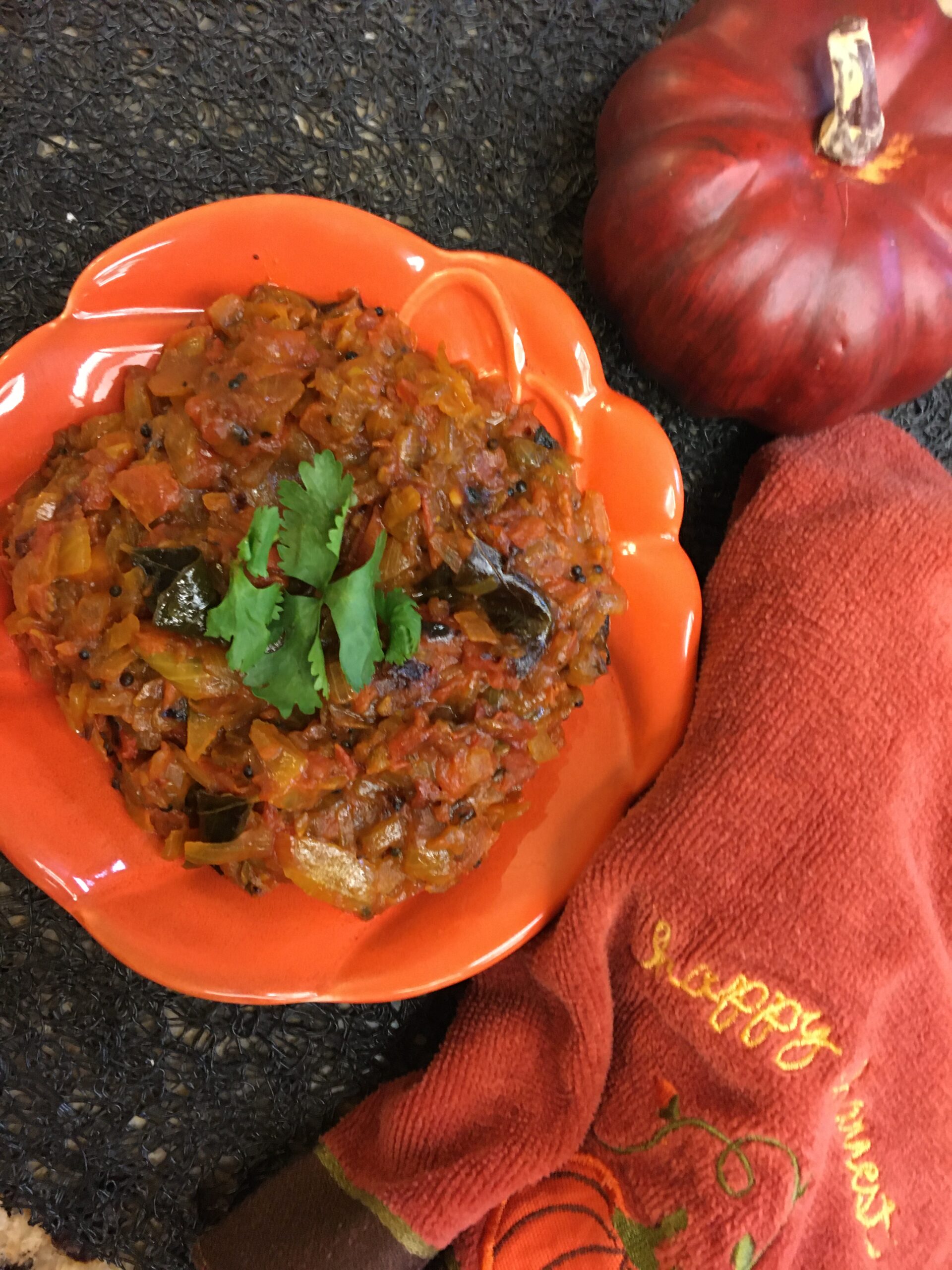
Tomato Chutney
Ingredients
- 1 lb tomatoes (diced)
- 5-6 curry leaves ((optional))
- 1-2 green chilies, sliced in half ((use according to your taste for spiciness))
- ¼ tsp mustard seeds
- 3-4 oz onions - Approximately, 1 medium peeled, sliced, or chopped ((I slice them thin, and then cut them across in half, so I don't have the long strands of onion. Your preference!))
- 1 tsp salt ((or to your taste))
- ¼ tsp tumeric
- ¼ tsp red chili powder ((optional))
- 2 tbsps finely chopped cilantro
- 2-3 tbsps cooking oil
Instructions
- Heat oil in a deep saucepan on medium heat.
- Add mustard seeds, when spluttering stops, less than 30 seconds.
- Add curry leaves, stir till they turn slightly dark, 30 seconds.
- Add green chilies and onions. Do this in quick succession as you do not want to burn the mustard seeds.
- Cook onions for about 4-5 minutes till onions turn translucent and start to brown at the edges.
- Add the turmeric and red chili powder.
- Stir about 4 times and then add the tomatoes.
- Cook till tomatoes start to curl, and the oil starts to surface on the sides. About 10-15 minutes.
- Garnish with chopped green coriander.
Notes
It is a Saturday afternoon, and our cook is in the kitchen, ready to cut a huge pile of freshly washed bhindi (okra). My twin sister and I stand patiently by, waiting for him to start cutting the bhindi. He slices the heads and tails off, and then the bhindi is chopped for the sabzi.
As soon as he’s done, we quickly pick up the cut heads and stick them all over our faces. Walking out of the kitchen, we go in search of our younger siblings and pretend that we have a dreadful and mysterious skin disease. Of course, they don’t buy it. But our two-year-old baby sister catches sight of us and freaks out.
We quickly remove the bhindi heads from our faces before the situation escalates to a mom appearance! The bhindi heads are slimy, so a swift wipe with the edge of our frocks (dress) takes care of that mess, and we rush to cajole our sister.
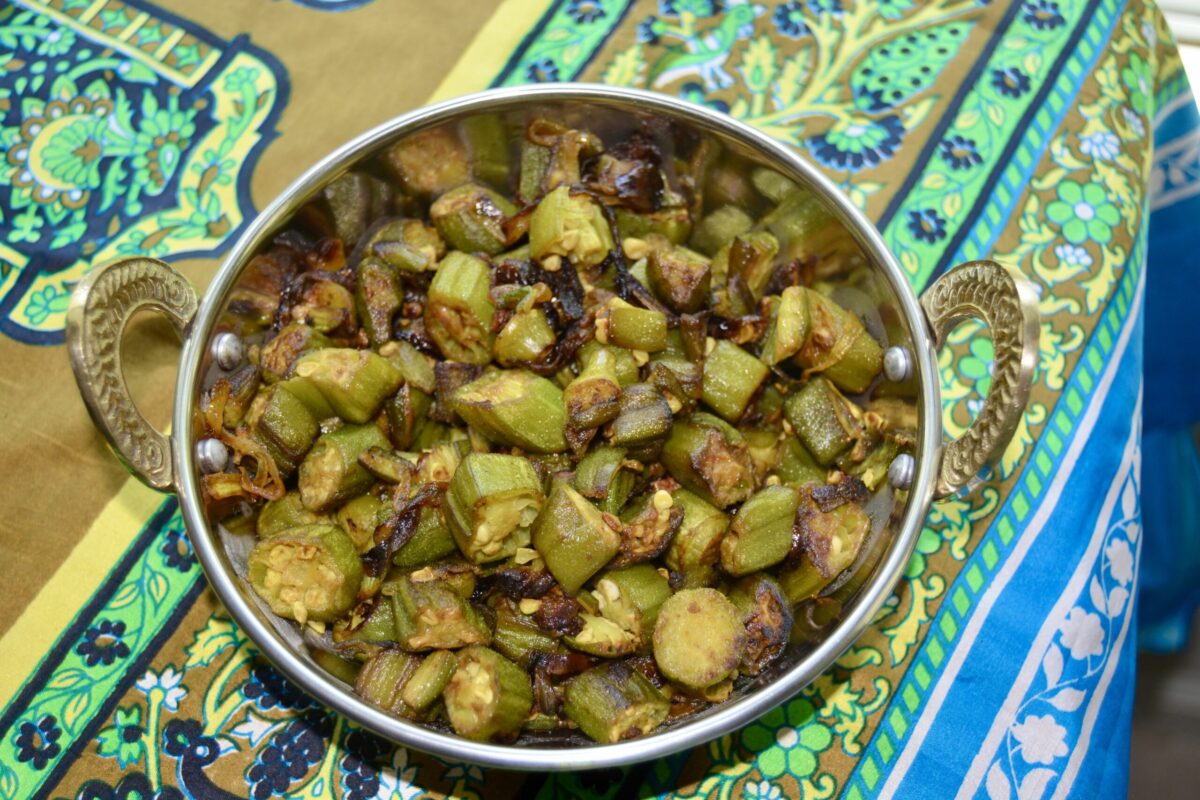
Bhindi Sabzi (Sauteed Okra)
Ingredients
- 1 ½ lb fresh okra (or 1 lb frozen okra (which, in the interest of time, I prefer))
- ½ large yellow onion (or 1 medium shallot) (sliced fairly thin)
- 1 dry red chili broken in half ((optional / to your taste))
- 1 1 tsp turmeric
- 1 tsp cumin powder
- ¼ tsp chili powder ((optional / to your taste))
- ¾ tsp salt ((or to your taste))
- 2-3 tbsp cooking oil
Instructions
- Wash the bhindi, then spread them on a paper towel to dry.
- Cut the heads off the bhindi and then slice evenly, about ½ inch thick. The knife gets slimy, so keep a paper towel handy to keep wiping the blade. If using a frozen pack, pour it into a colander and toss or shake it a few times to eliminate any ice crystals.
- In a broad (10 inch) skillet heat, 2-3 tablespoons of the oil on medium heat.
- Add the broken red chili, stir for 30 seconds, and then add the sliced onions.
- Sauté the onions for 2 minutes until tender.
- Add turmeric, cumin, and chili powder.
- Stir the spices into the onions, 30-40 seconds.
- Now add the bhindi and spread it out on the pan.
- Cover the pan and let cook on medium-low for 2minutes, then uncover, so the vegetable does not get slimy.
- Stir carefully and occasionally to brown the bhindi on all sides. It is important to do this so that the bhindi remains intact—especially the frozen ones.
- When the moisture evaporates, 10-15 minutes (a little longer for the frozen) turn off the heat, cover with a splatter guard so that no moisture can build up, and make them soggy.
- If the fresh bhindi gets too dry when cooking, then you can cover it.
- Let it rest for about 5 minutes before serving.
Notes
Today is Karva Chauth (or Karwa Chauth).
Usually, falling in the month of October, Karva Chauth is the fourth day of the Harvest moon. Most married Hindu women go on a fast from dawn to moonrise for the long life of their husbands. It is a religious festival that has now become a social event. The markets are usually crowded with shoppers looking for different colored bangles (bracelets), gifts, Indian sweetmeats, and dishes traditionally eaten on this day. Mothers-in-law will gift their bahu (son’s wife) with an outfit or fine jewelry for keeping the fast. The women get up early morning to bathe and pray and eat their fill before sunrise! Traditional fasters do not eat or drink anything after that until moonrise.
I stand over the sink scrubbing the potatoes under running water before I put them to boil. Our son and daughter-in-law are coming over for the weekend. It will be great to see them!
Indian cuisine varies from state to state. This trip, I decide on a South Indian style brunch from recipes I learnt from Mama who was from the southern part of India. The potatoes are a perfect accompaniment for dosas which are typically South Indian crêpes made out of fermented rice and urd dal (matpe bean) flour. The crêpes are also served with coconut chutney and Sambar dal to complete the meal.
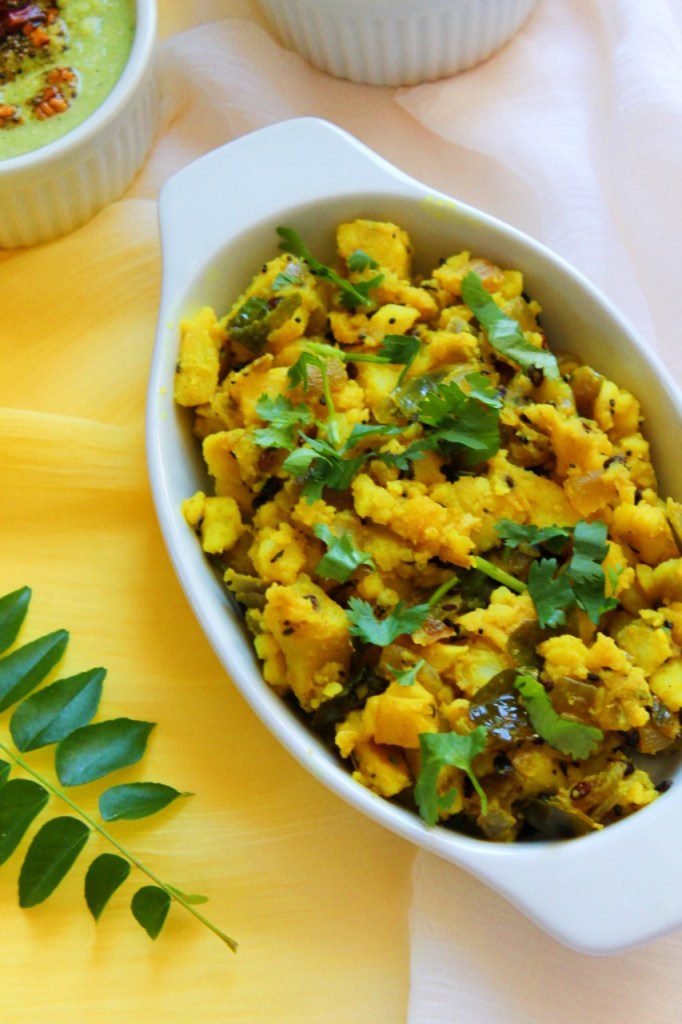
Dosa Allu: South Indian Style Potatoes
Ingredients
- 5-6 medium sized boiled Russet potatoes (peeled and chopped into bite sized bits)
- 1 medium sized yellow onion (or 2 shallots, chopped fine)
- 1 green Serrano, diced (optional, omit or increase to taste)
- 1-2 tsp turmeric powder
- 1 tsp black/brown mustard seeds
- ½ tsp channa dal, soaked in warm water for 15 minutes and drained ( optional)
- ½ tsp urd dal, soaked in warm water for 15 minutes and drained (optional)
- 6-10 curry leaves (available at any Indian grocery store. You can omit this but it gives the dish a distinctive taste.)
- 2 tsp salt
- ¼ cup chopped fresh cilantro (green Coriander leaves)
- 4-5 tbsp oil
Instructions
- Heat oil in a wok or deep pan on medium heat. Add the mustard seeds until they pop and splutter for a few seconds. Then add the curry leaves and chopped green chilies (be careful of splutter burns!!). If you are adding the lentils, now would be the time to do so.
- About 15-20 seconds after you add the mustard seeds (and lentils), add the chopped onions. Sauté for 5-6 minutes until the onion starts to turn half brown.
- Add the turmeric powder, stir for a second or two, then add the boiled potatoes and salt to taste.
- Stir the potatoes, breaking them up further to a half-mashed consistency. You may need to add a little more cooking oil if they look too dry.
- Add the chopped cilantro and continue to stir until the masala is well blended.
- Remove from stove. Let sit a few minutes before serving.
Notes
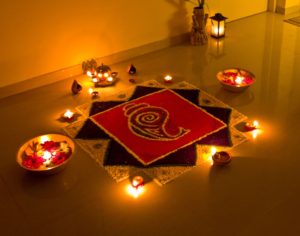 Deepawali (or ‘Diwali, the “festival of lights”) is an ancient Hindu festival celebrated in autumn (northern hemisphere) or spring (southern hemisphere) every year. Arguably the most important festival in Hinduism, it is an official holiday in Fiji, Guyana, India, Pakistan, Malaysia, Mauritius, Myanmar, Nepal, Singapore, Sri Lanka, Suriname and Trinidad and Tobago. The festival spiritually signifies the victory of light over darkness or good over evil, knowledge over ignorance, and hope over despair. Its celebration includes millions of lights shining on housetops, outside doors and windows, around temples and other buildings in the communities and countries where it is observed. The festival preparations and rituals typically extend over a five-day period, but the main festival night of Diwali coincides with the darkest, new moon night of the Hindu Lunisolar month Kartika. In the Gregorian calendar, Diwali night falls between mid-October and mid-November.
Deepawali (or ‘Diwali, the “festival of lights”) is an ancient Hindu festival celebrated in autumn (northern hemisphere) or spring (southern hemisphere) every year. Arguably the most important festival in Hinduism, it is an official holiday in Fiji, Guyana, India, Pakistan, Malaysia, Mauritius, Myanmar, Nepal, Singapore, Sri Lanka, Suriname and Trinidad and Tobago. The festival spiritually signifies the victory of light over darkness or good over evil, knowledge over ignorance, and hope over despair. Its celebration includes millions of lights shining on housetops, outside doors and windows, around temples and other buildings in the communities and countries where it is observed. The festival preparations and rituals typically extend over a five-day period, but the main festival night of Diwali coincides with the darkest, new moon night of the Hindu Lunisolar month Kartika. In the Gregorian calendar, Diwali night falls between mid-October and mid-November.
Read more on Wikipedia.

